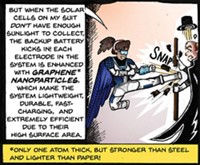Advertisement
Grab your lab coat. Let's get started
Welcome!
Welcome!
Create an account below to get 6 C&EN articles per month, receive newsletters and more - all free.
It seems this is your first time logging in online. Please enter the following information to continue.
As an ACS member you automatically get access to this site. All we need is few more details to create your reading experience.
Not you? Sign in with a different account.
Not you? Sign in with a different account.
ERROR 1
ERROR 1
ERROR 2
ERROR 2
ERROR 2
ERROR 2
ERROR 2
Password and Confirm password must match.
If you have an ACS member number, please enter it here so we can link this account to your membership. (optional)
ERROR 2
ACS values your privacy. By submitting your information, you are gaining access to C&EN and subscribing to our weekly newsletter. We use the information you provide to make your reading experience better, and we will never sell your data to third party members.
People
Intel Announces Science Talent Search Winners
by Lauren K. Wolf
April 20, 2009
| A version of this story appeared in
Volume 87, Issue 16
THE $100,000 top prize at this year’s Intel Science Talent Search (STS) went to Eric K. Larson, a student at South Eugene High School, in Oregon, whose project focused on mathematics. But student research in biochemistry and chemistry figured prominently at the STS Awards Gala, held on March 10 in Washington, D.C.
William J. Sun, 17, a senior at Parkway Central High School, in Chesterfield, Mo., won second place for his biochemistry project on golgicide A, an inhibitor of intracellular transport in bacterial toxins. Using cloning and gene-sequencing techniques, Sun demonstrated that a DNA sequence in the human gene GBF1 coding for a single amino acid could be altered to switch on resistance to golgicide A. The discovery could have implications for treating neurodegenerative disorders. For this accomplishment, the Intel Foundation awarded Sun a $75,000 scholarship, which he will apply toward his undergraduate education at either Harvard University or Yale University.
The STS prize for third place, a $50,000 scholarship, went to Philip V. Streich, 18, for chemistry research he carried out at the University of Wisconsin, Platteville, with mentor James P. Hamilton. According to Streich, a homeschooler, his project disproved the notion that carbon nanotubes are insoluble (C&EN, Nov. 10, 2008, page 35). He designed and built a light-scattering apparatus from “spare parts lying around the lab” and used it to identify N-methyl-2-pyrrolidone as a viable solvent for nanotubes, he told C&EN at the gala.
Streich, who cofounded a company on the basis of his discovery and who will attend Harvard in the fall, also won the Glenn T. Seaborg Award for scientific communication, which was established in honor of the late Nobel Laureate, who was an STS judge for four decades. The Seaborg Award’s winner is selected by all 40 STS finalists.
The Society for Science & the Public (SSP), a nonprofit science advocacy organization, has administered STS since its inception in 1942. Each year, some 1,600 high school seniors enter their original research projects for consideration. The field is narrowed to 40 finalists by a panel of judges and reviewers, and the finalists all receive a scholarship of at least $5,000 and a trip to Washington.
During their stay in Washington on March 5–10, the students met with President Barack Obama and presented their research in exhibits at the National Academy of Sciences. But the best part of the weeklong trip, Streich said during his Seaborg Award address, was “meeting and hanging out with an extraordinary bunch of brilliant and fascinating finalists.” Seven STS participants have gone on to win Nobel Prizes, including Roger Tsien, last year’s winner of the prize in chemistry.
Gen. Colin L. Powell, former Secretary of State, and Energy Secretary Steven Chu addressed the finalists at the awards ceremony. Chu encouraged the students to continue to strive for excellence in their work. Science, he said, “is pushed by people—especially young people.”




Join the conversation
Contact the reporter
Submit a Letter to the Editor for publication
Engage with us on Twitter